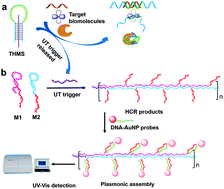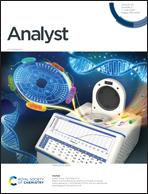Establishment of a universal and sensitive plasmonic biosensor platform based on the hybridization chain reaction (HCR) amplification induced by a triple-helix molecular switch†
Abstract
Herein, we established a universal and sensitive plasmonic sensing strategy for biomolecule assays by coupling the hybridization chain reaction (HCR) strategy and a triple-helix molecular switch. Upon the recognition of the target, a single-stranded DNA as a universal trigger (UT) was released from the triple-helix molecular switch (THMS). Thus, the HCR process can be triggered between two hairpins M1 and M2, resulting in the aggregation of gold nanoparticles (AuNPs) via the hybridization between the tail sequence on M1 (or M2) and a DNA–AuNP probe with a dramatic change in the absorbance at 521 nm. More specifically, the strategy, which was conducted by the introduction of target-specific recognition of THMS and universalized by virtue of altering the aptamer or DNA sequence without changing the triple-helix structure, enables simple design for multiple target detection. By taking advantage of THMS, this strategy could enable stable and sensitive detection of a variety of targets including nucleic acids, small molecules and proteins, which may possess great potential for practical applications.



 Please wait while we load your content...
Please wait while we load your content...